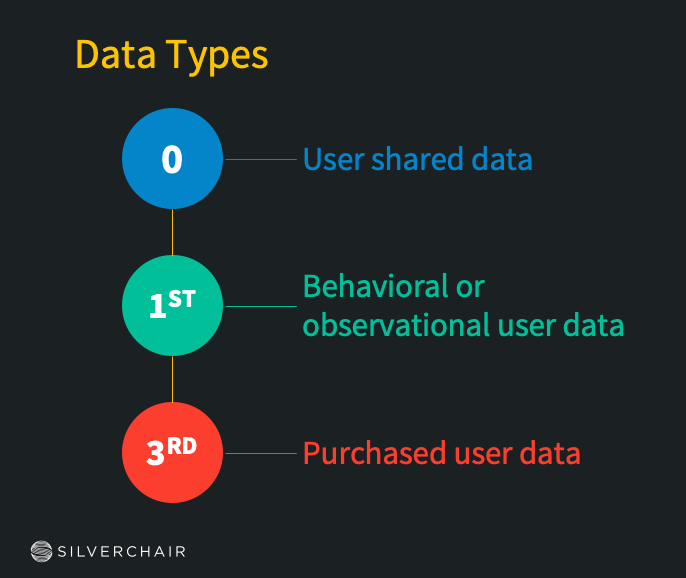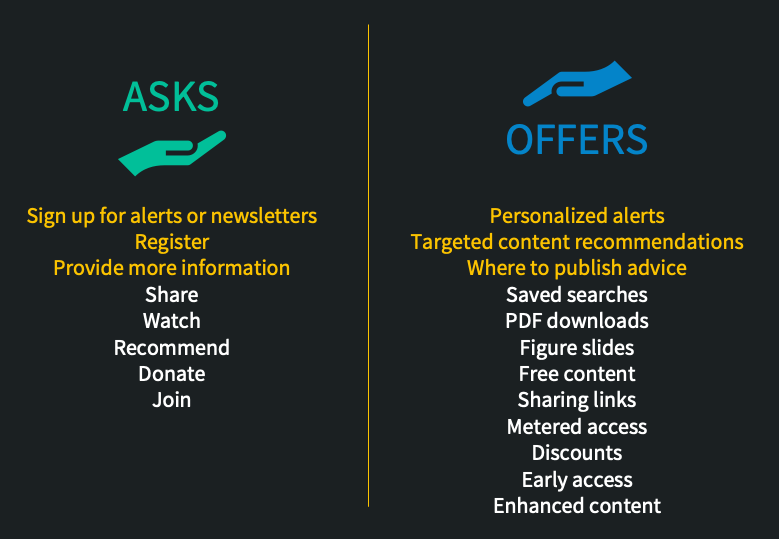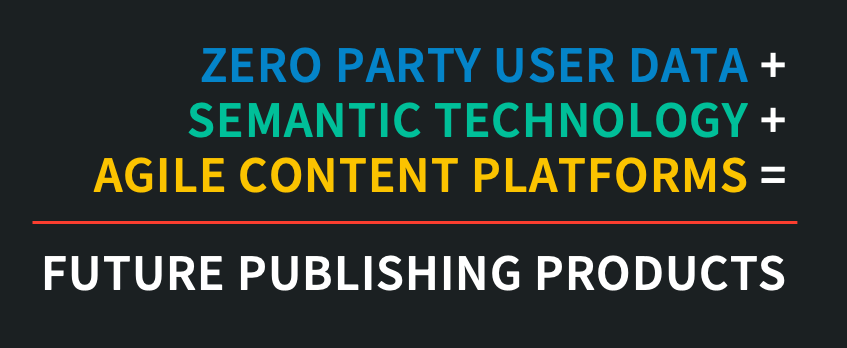What is Zero-Party data?
“Data that a customer intentionally and proactively shares with a brand, which can include preference center data, purchase intentions, personal context, and how the individual wants the brand to recognize [them].” —Forrester Research

Very simply, zero-party data is information an author, member, subscriber, or reader purposefully gives you. Users sharing their data is an incredibly common and long-running practice. Society members frequently share information about their academic or practice disciplines. Readers will share content topics they’re interested in. What is changing is how we can use marketing technology to make this data actionable (as well as the laws, policies, and user expectations around this data).
I know talking about user data is scary territory. I’m still processing my trauma from the 2010 Canadian Anti Spam Law. The thought of buying user data, or your personal data being sold, is problematic. That’s why I’m focusing in on zero-party data, and to some extent first-party data, which includes data gained from user sessions, such as what they click on, download, or purchase.
On most scholarly content hosting platforms, zero- and first-party data is used for on-site personalization or content recommendations, to improve search results, or to send custom alerts or emails. Doing this doesn’t require the dark arts or black boxes, and if you haven’t encountered this in our market, you certainly have when you read your favorite popular magazine or major metro newspaper on your phone or online.
What does this look like? How can publishers capture zero-party user data? Ask users to register or sign in. Ask users to tell you what topics they’re interesting in reading with select modals or typed terms tied to a classification scheme or taxonomy. Ask users to provide a bit more information about themselves to continue reading. Or to sign up for an email newsletter.

These are all relatively simple asks that amount to something seemingly primitive: a value exchange between the publisher and her reader.
Publishers in our industry are in the extraordinary position of publishing incredibly useful content. Your brands are trusted. And while most of your users are a step removed from your ultimate purchasers, as a publisher, you deliver enough value to your end-users to make asks of them.
There are lots of asks you can make of your users and valuable offers you can provide in return. This isn’t a new concept. What is new, and what has changed, is user behavior, the maturity of our products and technology, and ease or cost of making these asks and offers.
We now have analytic tools that give us a far richer understanding of our users and how the interact with our content. Our platforms and products have vastly improved user experiences. Marketing technology can make less intrusive asks of our users. Registering or even paying for high-quality content, regardless of the market segment, is increasingly common and accepted.
Our users have big jobs to do. They’re overloaded with information, they're stressed, and now, they're often without institutional resources or support that made finding, accessing, and using content just a bit easier.
In the three or four minutes a user with their big job to do is on our sites, asking or determining who they are (student, researcher, clinician) and what they content they are looking for can save them time and effort. We can use the data we've gathered to provide personalized and increasingly accurate content recommendations, or, subsequently, an email the latest published content in their domain. That email can have access or referrer links built in, so when the busy user clicks through, they're straight into the full-text content they want. This is the service our subscribers, members, and readers are coming to expect. These services are also valuable and shouldn’t be given away for nothing. This all takes a little curiosity and ingenuity.

Making asks and creating value exchanges creates a funnel or conversion strategy. Through analytics and your offers, you’re attempting to capture the small but important percentage of users who value your content and will regularly return to your site. Yes, you’ll still have a high bounce rate. Yes, your average time on site will seem impossibly short and the typical user will only view a page or two. But you're trying to skim the cream here.
If you’re experimenting, if you’re delivering value, you should, in time, see your pool of registered users grow. Your newsletter subscribers increase. The growth of your direct and email-driven traffic should outpace search. The cream you're skimming will be your authors, reviewers, members, or attendees, or they’ll be the institutional users you want to frequently download your content. It’s your loyal audience and any publisher worth their salt will know the value of capturing them.

There’s plenty of data from smart marketers and publishers who are using conversion optimization tooling to boost newsletter sign-ups or the rate at which online readers become members. Some savvy folks are even using A|B testing on user captures or email newsletters to improve outcomes. While that’s important work, it is, I hope, increasingly workaday.
What excites me is product experimentation that’s happening right now by publishers who are taking advantage of the marketing and publishing technologies we've been talking about develop customer centric digital products.
As an industry, we’ve made good but unequal progress in converting our print products and processes into digital ones but there still are vestiges, particularly in our product and sales strategies. By and large, publishers are still selling bundles of journals, collections of books, and the standalone reference work. These product divisions represent how we organized our companies, sold our product to libraries, and built our first publishing platforms.
But what use are these siloed products to users today?
In my community of publishers, there’s a shift from segmented products to user-centric content channels or collections-on-steroids. These channels combine various types of user-valued content into one package. These channels use automation and semantic tooling to gather a publisher’s archival and latest content together. They use zero- and first-party user data to target or personalize what content is presented to their users. These “channels” are being developed in response to market pressures, including the need for more focused products with greater utility to institutional end-users or that appeal to price sensitive corporate or department-level rather than library customers. We’re also seeing channels used to build engaged communities of authors, members, and readers, anchoring product line expansions or reinforcing a publisher’s brand in an area. These are hopefully products that capture users’ attention, create market value, and enjoy commercial success.
Even now, when aggregation, consolidation, and dissociation of content feel inevitable in our industry, we’re in a time where the technology and know-how to experiment or pursue these strategies is increasingly available and affordable, even to a small society or independent publisher.
There will always be a need to deliver expert and trusted content to specialized audiences. That’s ultimately a niche rather than scale play but we’re finally getting the digital tools to succeed.